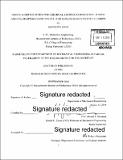| dc.contributor.advisor | Ahmed F. Ghoniem. | en_US |
| dc.contributor.author | Zhao, Zhenlong | en_US |
| dc.contributor.other | Massachusetts Institute of Technology. Department of Mechanical Engineering. | en_US |
| dc.date.accessioned | 2017-01-30T19:18:04Z | |
| dc.date.available | 2017-01-30T19:18:04Z | |
| dc.date.copyright | 2016 | en_US |
| dc.date.issued | 2016 | en_US |
| dc.identifier.uri | http://hdl.handle.net/1721.1/106783 | |
| dc.description | Thesis: Ph. D., Massachusetts Institute of Technology, Department of Mechanical Engineering, 2016. | en_US |
| dc.description | Cataloged from PDF version of thesis. | en_US |
| dc.description | Includes bibliographical references. | en_US |
| dc.description.abstract | Chemical-looping (CL) is a novel and promising technology for several applications including oxy-combustion for carbon capture, hydrogen production and CO2 reuse. In this process, oxygen carriers are utilized to cyclically adsorb and release oxygen producing two separated exhaust streams with desirable products. A rotary reactor design with micro-channel structure was developed in the Reacting Gas Dynamics Lab (RGDL) at MIT, which exhibits superior performance over conversional designs. Preliminary simulation identified OC redox kinetics and material characteristics as keys to the success of CL technology. This thesis examines the fundamentals of the reduction and oxidation (redox) processes with the aim of achieving fast and reliable reaction kinetics for CL applications. Experiments are conducted in a button-cell fixed-bed reactor with an on-line mass spectrometer. The timeresolved kinetics are modeled with consideration of thermodynamics, surface chemistry, transport mechanism, and structural evolution. Our approach, combining well-controlled experiment and detailed kinetics modeling, enables a new methodology for identifying the rate-limiting mechanism, examining the defect electrochemistry, and designing alternative materials for chemical-looping technology. Redox study with nickel thin foils reveals that structural evolution is the determining factor. Nickel oxidation starts via nucleation of oxide grains, which overlap and annihilate the fast diffusion paths. The model shows that the reaction is limited by the decreasing ionic diffusivity. To achieve practical redox repeatability, NiO fine particles supported on YSZ nanopowder is tested, and superior kinetics and cyclic stability are observed. Fast oxygen exchange is achieved from 500 to 1000°C with sufficient utilization of the carrying capacity within 1 min. Improvement is attributed to the enhanced ionic diffusivity with YSZ. The use of ceria nanopowder exhibits an order of magnitude H2 production rate improvement as compared to the state-of-the-art. Ceria reduction is slow with a threshold temperature of 700°C. The model reveals that the charge transfer is the rate-determining step for H2 production. Improving H2 splitting requires: (i) reducing the defect formation enthalpy, and (ii) accelerating charge-transfer. The addition of Zr lowers the threshold temperature to 650°C with 60% improvement in the rates, resulting from 40% decrease in the defect formation enthalpy. Doping ceria with Pr 3+ further lowers the threshold temperature to 600°C while doubling the peak rate. The model reveals that the high concentration of surface defects achieved from either approach promotes adsorbate formation, thus accelerating the splitting steps. Similar conclusions are obtained for CO2 splitting. Using the derived kinetics, H2-syngas co-production with CH4 as fuel is examined. Two important stages are identified: the formation of the complete products on oxidized surface, and syngas on the reduced surface. CH4 reduction is found to be rate-limited by the slow fuel cracking reaction. To accelerate the kinetics, a novel perovskite-nickel composite OC is examined, in which nickel effectively catalyzes reduction, leading to an order of magnitude faster kinetics at 600-700°C. This project has clearly demonstrated that using novel materials, CL technology can provide an efficient solution to oxy-combustion based CO2 capture, and H2/syngas co-production. Specifically, the use of NiO/YSZ achieves fast kinetics, robust stability and sufficient OC utilization from 500 to 1000°C, enabling complete CO2 capture with minimum energy penalty. The ceria-, and perovskite-based OCs exhibit over an order-of-magnitude faster kinetics compared to the state-of-the-art, enabling improved H2 production/CO 2 reduction efficiency isothermally at 600-700°C. In-depth understanding gained on the redox fundamentals will shed light on the design and fabrication of new materials as well as optimization of the CL applications. | en_US |
| dc.description.statementofresponsibility | by Zhenlong Zhao. | en_US |
| dc.format.extent | 448 pages | en_US |
| dc.language.iso | eng | en_US |
| dc.publisher | Massachusetts Institute of Technology | en_US |
| dc.rights | MIT theses are protected by copyright. They may be viewed, downloaded, or printed from this source but further reproduction or distribution in any format is prohibited without written permission. | en_US |
| dc.rights.uri | http://dspace.mit.edu/handle/1721.1/7582 | en_US |
| dc.subject | Mechanical Engineering. | en_US |
| dc.title | Redox kinetics study for chemical-looping combustion, water and CO₂ splitting using nickel and cerium-based oxygen carrier | en_US |
| dc.title.alternative | Redox kinetics study for CL combustion, water and CO₂ splitting using nickel and cerium-based oxygen carrier | en_US |
| dc.type | Thesis | en_US |
| dc.description.degree | Ph. D. | en_US |
| dc.contributor.department | Massachusetts Institute of Technology. Department of Mechanical Engineering | |
| dc.identifier.oclc | 970378957 | en_US |
